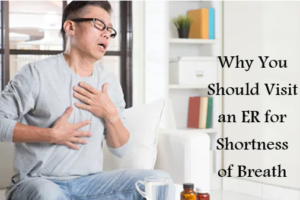A respiration rate of 16-20 breaths per minute is considered normal for healthy adults. If the respiration is under 12 breaths per minute, it is called shortness of breath (dyspnea). Most of the cases of shortness of breath are due to heart diseases or lung conditions. Both lungs and heart are responsible for transporting oxygen to tissues and cells throughout our body. You may experience breathing problem after doing intense exercise or when you are suffering from cold or flu. But sometimes breathing problem can be a vital sign of a serious illness. If you or someone is suffering from a sudden and severe breathing problem, rush to an emergency room near you.
Conditions that can make you feel short of breath
There is no standard definition to explain the severity of shortness of breath. When you face difficulty in breathing lying down or while doing any normal activity or you feel like you aren’t getting enough air, it is a sign of breathlessness.
Common Causes:
- Asthma
- Chronic obstructive pulmonary disease
- High blood pressure
- Lung disease
- Obesity
- Anxiety
Chronic Causes:
- Heart attack
- Heart failure
- Choking
- A blood clot in lungs
- Pneumonia
- Collapsed lungs
- Allergic reactions
When does it happen?
- When carbon dioxide level increases in your blood
- When oxygen level decreases in your blood
- When lungs are unable to expand
- When the heart is unable to pump blood properly
When It’s An Emergency?
If you have a history of asthma and you are familiar with this, then you can use your inhaler. You will be all right after a while. But if you are a person who typically never felt any breathing problem, throat tightness, and speech difficulty due to shortness of breath, then don’t wait too long, ask your family member to drive you down to an emergency room near you. Rush to an emergency room when:
- When your feet swell
- Lips turn blue
- Noise when breathing
- High fever and chills
- Breathlessness that does not go away after taking some rest
- Decreasing level of consciousness
Depending on how severe it is, a certified doctor at the emergency centre will recommend diagnostic tests and provide you treatments accordingly.
Treatment for Breathing Difficulty
The treatment for shortness of breath will depend on the cause. Breathing difficulty poses a tough diagnostic challenge. Some of the common diagnostic tests that doctors perform to identify the exact cause behind your problem:
- Electrocardiogram to look for signs of heart attack
- Chest X-Ray to identify if there is an infection in your lungs
- CBC blood test to check for anaemia and other causes
- A CT scan of your chest to identify whether you’re suffering from a chronic pulmonary obstructive disease (COPD) or not
- Echocardiogram to look for heart problems
- Bronchoscopy to look for respiratory tract problems
Once the diagnosis is clear, doctors will provide you the right treatment to ease your symptoms and improve your condition. For instance, breathing difficulty stemming from COPD will require a proper treatment plan to reduce acute episodes of breathlessness. An asthma attack can be controlled using bronchodilators. Antibiotics are given in case of bacterial pneumonia.
Conclusion
Most cases of dyspnea are due to heart and lung diseases and anxiety. When you face breathlessness or see someone experiencing breathing difficulty, just search “emergency room near me” and rush to the nearest emergency centre for immediate treatment.
Families in Lufkin, TX and surrounding areas trust HOPE ER for all their medical emergencies. We are a licensed emergency room and offer medical care, 24/7.
Visit us at 2111 East Denman Avenue, Lufkin, Texas 75901. Phone: (936) 899-7243
